As the climate crisis increasingly alters the planet, Indigenous Peoples around the world are disproportionately affected. Their livelihoods, identities and well-being have traditionally relied on lands and natural resources, and the regions they inhabit are susceptible to extreme weather events such as heatwaves, droughts, heavy rainfall and the thawing of permafrost. Indigenous Peoples are on the front line of the climate crisis, despite having contributed little to global emissions.
These communities have lived in close relationships with their environments for thousands of years, developing sustainable ways of life, protecting natural ecosystems and adapting to changes such as climate variations and human-made disasters. Indigenous cultures, traditions and spirituality are connected to their environment. Invasions, colonizations, land dispossession and, in some cases, forced migrations have led to many Indigenous communities losing their rights, facing poverty and living in vulnerable regions with reduced capacities to adapt to the climate crisis.
The confluence of these factors means that Indigenous Peoples are uniquely placed to provide sustainable adaptations to mitigate the climate crisis, drawing on their bodies of knowledge, ontologies, practices, ethical values, beliefs and traditions that have been passed down through generations. Today, almost 500 million people — around 6% of the global population — are members of Indigenous groups, including the authors. Indigenous Peoples steward more than one-quarter of lands around the globe, which contain 80% of Earth’s remaining biodiversity.
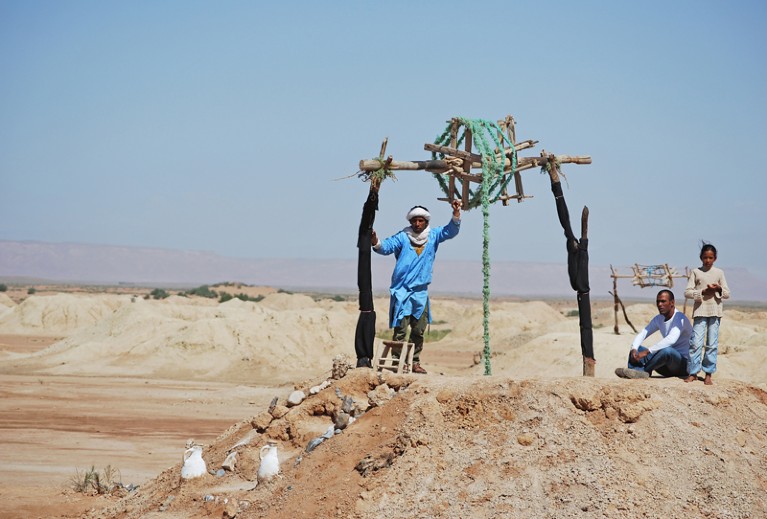
A man draws water from the khettara system of wells and canals in the Dadès valley, Morocco.Credit: Antonio Ciufo/Getty
Indigenous Knowledge (also called Traditional Knowledge, Indigenous Science and Traditional Ecological Knowledge, recognizing that it is not a monolithic knowledge system) contains dynamic and holistic understandings of stewardship and the world. Undervalued and dismissed in the past century or so, Indigenous Knowledge is increasingly being documented and recognized as key to tackling the many challenges facing humans today, including sustainable adaptation to changes in the climate1.
We call on Indigenous Peoples around the world to co-create a dialogue to develop sustainable partnerships and take active roles in the global discourse on climate resilience. We also call on decision makers and policymakers worldwide to involve Indigenous Peoples in local and global biodiversity conservation endeavours. Young members of Indigenous communities, in particular, serve crucial roles in bridging older and future generations, and are well placed to combine Indigenous Knowledge with modern technologies and practices. For example, they had important roles during the COVID-19 pandemic, often taking the lead to ensure food security for their communities2.
Local adaptations have global reach
As Indigenous People, we are grounded in our own place. Here, we present examples from various regions of sustainable Indigenous practices, which in some cases have been adapted to overcome climate effects. Although not every region is represented in our examples, we are keen to connect with youths from all parts of the world, including those in the Pacific and Central and South America, and to engage in a wider, global dialogue.
Northern Africa and part of the Sahel region is home to the Amazigh people, who are hunter-gatherers, pastoralists and farmers. Most live in, or on the borders of, deserts, where they have adapted to hot summers and cold winters that have low rainfall. For centuries, they managed water using the khettara system — a network of wells and sloped underground canals that delivers drinking and irrigation water from aquifers to fields, relying only on gravity. Before the 1970s, the system was maintained collectively by communities, who removed dirt or stones from the canals, particularly after floods. It has since fallen largely into disuse and has been replaced by pumps, which often lead to over-extraction of underground water.
However, in the past five years or so, young people in the Tata region of Morocco have taken the lead to restore and maintain the khettara system, as heatwaves and droughts have become more frequent and severely affected food and water security there. Solar-powered pumps have been installed to increase flow in the old khettaras, ensuring collective access to water. Overuse of groundwater resources remains an issue, however. Restoring khettaras through in-depth cleaning of existing canals and the building of new ones would be beneficial, but support from local authorities is needed to carry out such works.
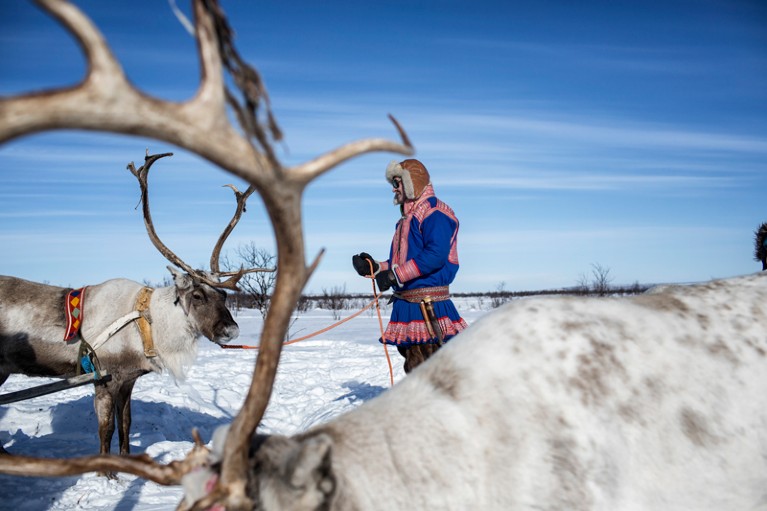
Indigenous Sámi people in the northern Scandinavian Peninsula rely on reindeer for survival.Credit: Nadia Shira Cohen/The New York Times/Redux/eyevine
The Arctic is also severely impacted by the climate crisis. The region has warmed quicker than expected, and nearly four times faster than the global average since 1979. Of the roughly 13 million people who live in the wider circumpolar north region, around one million are Indigenous Peoples, comprising more than 40 ethnic groups. It is difficult to give accurate numbers because some countries define Indigenous differently, and not always in accordance with the sovereign status of Indigenous Peoples. For example, in Russia, Indigenous groups are not specifically recognized in legislation unless they are a “small-numbered” population, leading to the official recognition of only 40 of the 160 Indigenous communities.
Rapid changes in temperature and climate, and the premature thawing of lakes, rivers, sea ice and permafrost are disrupting many aspects of daily life for Indigenous communities in the Arctic. This ranges from natural resources and food security to travel routes and the solidity of buildings and other infrastructure. To document such changes, Inuit hunters in Canada began collaborating in 2006 with geomatics engineering students to use technologies for collecting and mapping data on the climate and animal movements; community members continue such documentation today.
This collaboration, called the Igliniit Project — igliniit being an Inuktitut word for trails routinely travelled — mounted a GPS receiver, mobile weather station and digital camera, developed together with the hunters, on each of their snowmobiles. As they go about their daily life, each device automatically records its location along with weather conditions (temperature, humidity and pressure). The hunters can input observations and information (such as about fallen trees) into the system manually, resulting in an evolving map of the Kangiqtugaapik area of Canada. The data track animal locations as well as climate-related changes, such as sea-ice extent, year on year. The project showed a need for further testing in other communities, but demonstrated through an interactive map that it can help with monitoring environmental, wildlife, cultural and land-use changes, as well as documenting place names.
In another project grounded in Indigenous need and innovation, tribal environmental associations in southeast Alaska came together in partnership with US federal agencies, universities and private industries to develop a laboratory to help prevent paralytic shellfish poisoning, which has become more common in the area. It occurs when people consume shellfish that contain toxins produced by algae that thrive in warm waters. The recent increase in seawater temperatures is likely to be making this threat more prevalent. When traditional food harvesters collect shellfish such as clams and mussels in the wild, the Sitka Tribe of Alaska Environmental Research Lab tests the shellfish for toxins, so that the harvesters know whether or not they are safe to eat.
In the Sápmi region, spanning parts of the northern Scandinavian Peninsula and Kola Peninsula in northwestern Russia, the Sámi people are facing rapidly changing conditions that are causing devastating losses to their reindeer herds. Many Sámi families rely on reindeer for survival, but the animals are beginning to experience heat stress as well as struggling to find their usual foods. Premature thawing and freezing of snow can lead to the formation of a layer of ice under the snow, preventing reindeer from easily reaching the lichen they eat. This rapid change is noticeable through the lens of Sámi ontology — “this new snow has no name”.
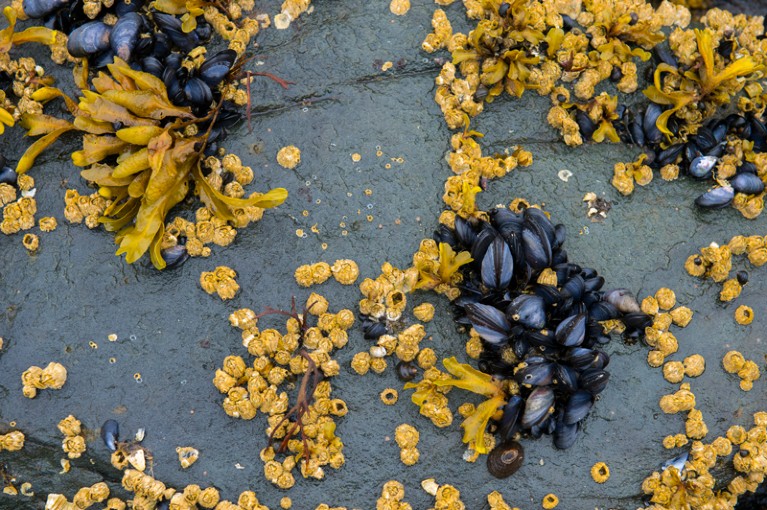
Alaskan mussels collected by traditional food harvesters are tested for toxins at the Sitka Tribe of Alaska Environmental Research Lab to check that they are safe to eat.Credit: Wolfgang Kaehler/LightRocket via Getty
Herders have adapted to these issues, to some extent, by migrating and by providing supplementary food for reindeer, but this changes the activities and behaviour of both the animals and the herders. Supplemental feeding is an extra expense and leads to an increased reliance on subsidies, which can reduce the herders’ ability to be independent and self-determining — an important aspect of Indigenous well-being, and of decolonization more generally3. The Sámi face further difficulties as temperatures keep rising and pastures continue to shrink4. Having to adapt rapidly to survive through traditional livelihoods isn’t an impending crisis, but is already a reality.
In North America, Indigenous Peoples live on lands that began to be colonized in the late 1400s and early 1500s. One example of an adaptation to climate change in Canada is the cultural burning practice revitalized by the Shackan, Xwisten and Yunesit’in First Nations governments. These prescribed fires served to manage land and ecosystems for thousands of years before they were made illegal during colonization. Controlled burning at appropriate times makes forests more resilient to wildfires and regenerates habitats for plants and wildlife, ensuring the sustainability of food systems and other resources. The fires are also of spiritual and cultural importance to Indigenous communities.
As wildfires have become more widespread worldwide, and forests have been burning out of control across North America, First Nations people are reaching out to harmonize Indigenous and non-Indigenous forest management approaches, a method that has also proved successful in California.
In Asia, involvement of Indigenous Peoples in the development of policies and practices has helped to protect their livelihoods and mitigate wider climate-driven issues. One example is the Tagal system in the Malaysian state of Sabah on the island of Borneo. Tagal — which means ‘prohibited’ or ‘do not’ in the local Kadazandusun language — regulates access rights and fishing on portions of rivers for periods of time set by the community.
The adoption of this Indigenous practice through collaboration between local communities and the Sabah fisheries department helped to restore the depleting aquatic biodiversity, prevent pollution in rivers and generate income for local communities through fishing and ecotourism. Fishing methods are also monitored to prevent the use of explosives, electrocution or poison. This system has been implemented in the neighbouring state of Sarawak, where it is known as Tagang (meaning ‘restricted’ in the Iban language).
Let young people take the lead
These examples show that discussions about the challenges of climate threats and methods of adaptation need to involve Indigenous Peoples. This will ensure that a holistic approach is taken. It is crucial that those who are most affected now and in the future are an integral part of the decision-making processes.
Indigenous youths in particular are most crucial to engage. They are custodians of Indigenous Knowledge with the responsibility and capacity to ensure the perpetuation of sustainable practices that the world can learn and benefit from. They can weave together Indigenous and non-Indigenous knowledge systems to address present demands without compromising those of future generations, ensuring that vulnerable populations are not left behind. For example, in Canada, the Yukon First Nations centred Indigenous cultures and identities through a youth-led climate action plan called Reconnection Vision.

Maize (corn) cultivated by Amazigh people on lands that have been flooded.Credit: Jamaa Aterkzi, Targa Ilmaten Association
We encourage Indigenous youths to co-create a dialogue on the climate crisis, in view of the urgency for collaboration and partnerships. One way to enable the exchange of ideas and approaches for climate-change mitigation and adaptation is through online conferences, such as the Global Indigenous Youth Summit on Climate Change. This 24-hour virtual dialogue on 9 August — the International Day of the World’s Indigenous Peoples — will be led by, for and among Indigenous youths. (All authors and co-signatories of this article are involved in organizing this event, for which Springer Nature, the publisher of Nature, is a sponsor; see also Supplementary information.)
Fill the knowledge gap
One issue that particularly affects young people is the widespread discrimination and forced assimilation that Indigenous Peoples have faced in many countries. This has disrupted transmission of Indigenous Knowledge through generations. For instance, to avoid discrimination in educational, professional and personal settings, many Indigenous Ainu people in Japan hid or continue to hide their Ainu identity, sometimes from their own families. Such barriers hinder young people from thinking about climate adaptations that are grounded in their own Indigenous tradition, as well as preventing wider dialogues among Indigenous Peoples.
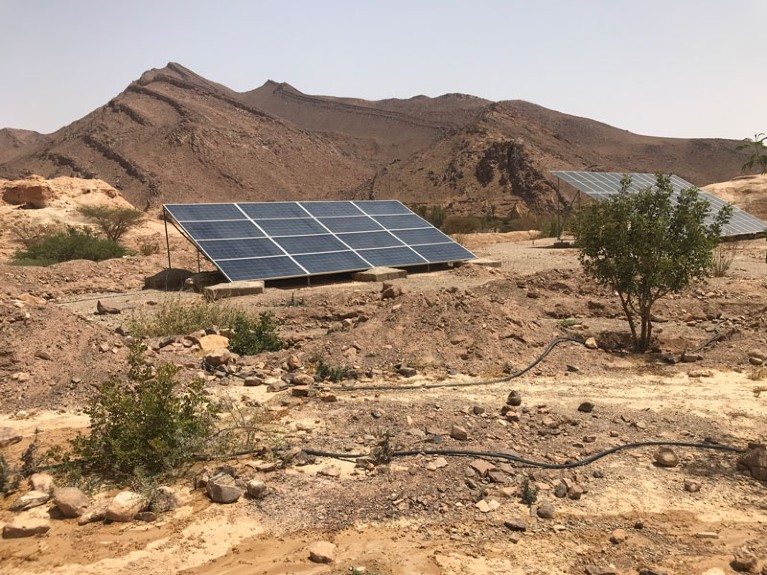
Solar panels are used to power pumps that maintain water flow in a khettara during dry seasons in the Tata region of Morocco.Credit: Lahcen El Youssfi
Although Indigenous Knowledge is often passed through oral traditions, written literature can provide another means of transmission. Lights of Okhotsk, an autobiography in Japanese by Ainu Elder Yoko Abe from Sakhalin, a Russian island north of Japan, includes photographs, detailed illustrations and poetry, as well as sections on traditional practices through the seasons5. For instance, Abe describes the preserved foods (dried herring, saffron cod and herring roe) in winter and the fish-skin footwear worn by her grandfather; catching fish in autumn; making juice with tree sap in summer and picking wild plants in spring. Books such as this can serve as a great resource for climate-adaptive practices and reach younger generations, some of whom are yet to learn of their heritage.
Foster Indigenous-led conservation
In discussions on the climate crisis, Indigenous Peoples bring millennia of Indigenous Knowledge, centuries of resilience and lifetimes of adaptation to extreme environmental conditions. There is no question that they should be an inherent part of the formal system of governance in their countries and on the international stage.
Governments worldwide need to look at the effectiveness and sustainability of Indigenous approaches, and consider returning lands and waters to Indigenous Peoples. Movements such as Land Back and Water Back advocate for decolonization and a sustainable approach to mother Earth. This does not mean that non-Indigenous people would have to move their homes and businesses, but that the nurture and stewardship of the lands and waters would be led by Indigenous Peoples, drawing on their knowledge. Although this would be ideal, we appreciate that in practice it is hard to achieve, because Indigenous sovereignty is not always respected in all parts of the world. However, the approach has seen success in Canada and the United States.
For example, in Utah, the five Tribes of the Bears Ears Commission, together with the Bureau of Land Management and the US Forest Service, have developed a formal co-management structure for the Bears Ears National Monument that incorporates Indigenous Knowledge. Such examples still tend to be the exception, but should be embraced increasingly by local and national governments.
Meanwhile, steps should be taken by nations and their local governing bodies to ensure that Indigenous Knowledge is appreciated and valued alongside other ways of understanding the world; this involves reforms to science education systems.
We recommend intermediate actions to ensure that Indigenous Peoples take the lead in sustainable land and water stewardship. Indigenous youths should take central roles in high-level global discourses, such as those fostered by the United Nations Framework Convention on Climate Change, the Convention on Biological Diversity, the Intergovernmental Panel on Climate Change, the Intergovernmental Science-Policy Platform on Biodiversity and Ecosystem Services and other such frameworks. Partnerships should be developed and perpetuated, especially between Indigenous youths from the global south and global north. Countries should learn from one another about how Indigenous-led stewardship can be legally embedded in local and national practices, through agreements with Indigenous Peoples and Tribes as sovereign entities.
To tackle the climate crisis, all stakeholders need to recognize that Indigenous Peoples are crucial in helping to restore ecosystem diversity and in ensuring the future of the planet is sustainable.

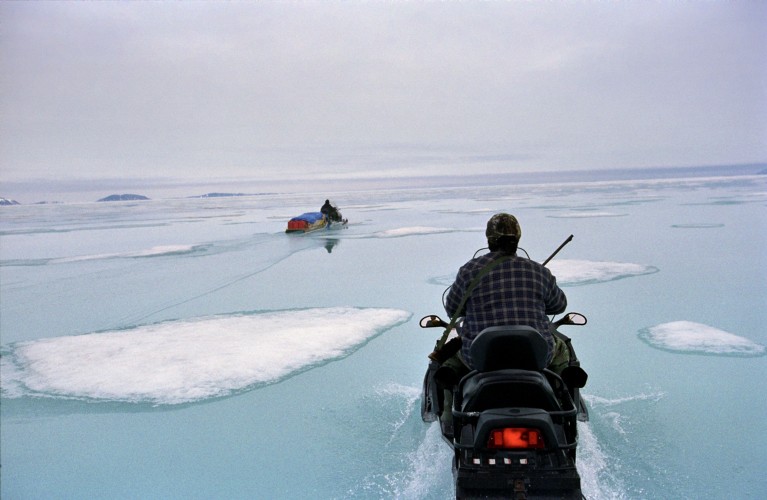
 Indigenous knowledge is key to sustainable food systems
Indigenous knowledge is key to sustainable food systems
 Current conservation policies risk accelerating biodiversity loss
Current conservation policies risk accelerating biodiversity loss
 Biodiversity loss and climate extremes — study the feedbacks
Biodiversity loss and climate extremes — study the feedbacks
 Why I’m leading Pacific Islands students in the fight on climate change
Why I’m leading Pacific Islands students in the fight on climate change
 The Cape Town Statement on fairness, equity and diversity in research
The Cape Town Statement on fairness, equity and diversity in research
 University ethics boards are not ready for Indigenous scholars
University ethics boards are not ready for Indigenous scholars





